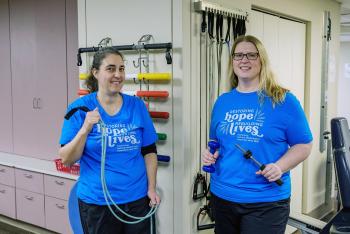School nurse Tamisha Nicole Jones shares her courageous journey of overcoming multiple brain...
Read More

If you’ve ever dealt with an injury before running in a race or another sporting event, you’ve probably wondered whether it’s safe to continue exercising and training. Although staying less active during recovery can be difficult, exercising while injured can hinder your healing. Here’s what you need to know about exercising while dealing with a sports injury.
“Sports injuries happen as a result of exercise or other physical activity,” said Ryan Cartwright, Certified Personal Trainer and Functional Strength Coach at Inspira Fitness Connection. “They have numerous causes, including overuse, improper technique and a sudden impact.” Sports injuries range from minor strains and sprains to more severe conditions, like fractures or tears. While they can occur in any part of the body, sports injuries are most common in the knees, ankles and shoulders.
Determining whether you can exercise while injured depends on the type and severity of your injury. Mild injuries like sprains or strains may allow for low-impact exercises such as cycling or swimming. However, injuries like fractures or torn ligaments require plenty of rest and proper medical attention.
“Before engaging in physical activity after a sports injury, make sure your pain, swelling and stiffness are significantly improved,” said Cartwright. “Pushing yourself too hard or too soon can exacerbate your injury and slow recovery.” Talk to your doctor about a recovery plan and identifying safe exercises while your body heals.
The best way to stay safe is to pay attention to your body and how it feels. If you experience pain or discomfort during or after exercising, it may be a sign you’re overdoing it. Start with low-impact exercises, like cycling, walking, swimming or yoga, and gradually increase the intensity as your injury heals.
“Do not train through pain. If there is pain in the range of motion for that exercise, try decreasing the weight or reducing the range of motion. If neither technique works, then skip that exercise all together,” said Cartwright. “Talk to your doctor or physical therapist to help determine which exercises and activities are safe for you while your body heals.”
It can be challenging to stay motivated while injured, but there are things you can do to help. “Set realistic goals for yourself and celebrate small victories,” said Cartwright. “Even low-impact exercises can help you maintain your fitness level and heal from injury.” Finding an exercise buddy or joining a support group is a great way to keep you accountable and motivated as you regain your footing.
Always warm up and stretch before exercising, which increases blood flow and flexibility and minimizes the risk of injury and joint pain. Using proper technique and form helps you move more efficiently and lowers your risk of injury. Wear appropriate gear and equipment for your workout and stay hydrated throughout. Gradually increase the intensity and duration of your exercise sessions and take rest days to allow your body to recover.
Inspira Fitness Connection locations are state-of-the-art, certified medical fitness facilities that can help you develop and maintain an active lifestyle. With a judgment-free atmosphere that welcomes people of all ages, backgrounds and fitness levels, Inspira Fitness Connection locations offer over 50 group exercise classes, personal training, massage therapy and more. Become a member of Inspira Fitness Connection today.
Inspira Health is a high reliability organization (HRO), which means safety is the top priority for patients and staff. To make an appointment, call 1-800-INSPIRA.

School nurse Tamisha Nicole Jones shares her courageous journey of overcoming multiple brain...
Read More
Physical rehabilitation focuses on making steady progress by using personalized care plans and a...
Read More
Continuing rehabilitation at home with a personalized recovery plan not only tailors exercises to...
Read More